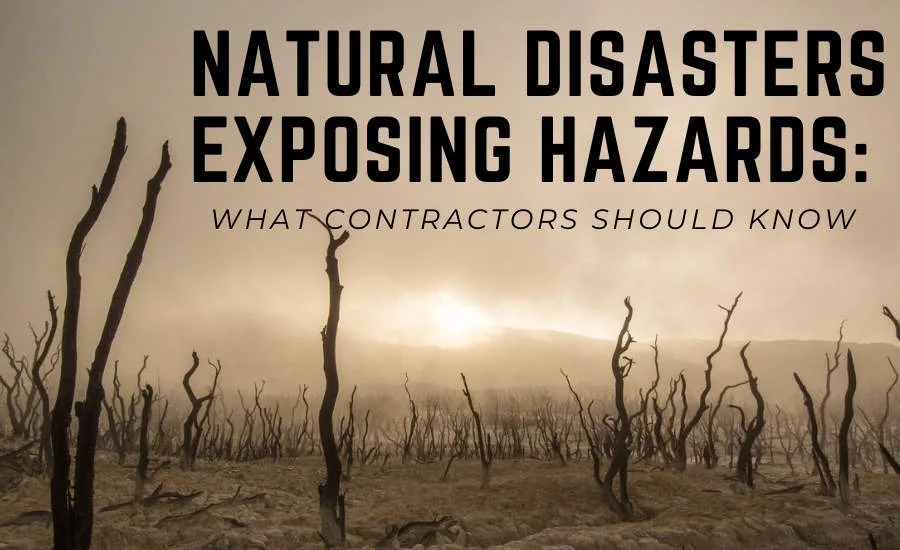Natural Disasters Exposing Hazards: What Contractors Should Know

As of July 2020, there have been 10 weather/climate disaster events with losses exceeding $1 billion in the US alone. Depending on the type of natural disaster faced, the remediation and cleanup from these events require specific care in order to maintain safety for those involved. Exposure to toxic materials, electrical hazards, and respiratory hazards are just a few things to be aware of during disaster cleanup. Workers and volunteer experience levels vary, which makes it crucial to advise individuals on relevant dangers so cleanup crews are able to work together to ensure safety and efficiency.
Wildfires
Wildfires are categorized as “unplanned and unwanted fires.” This can mean anything from fires caused by lightning to planned projects that escaped their scope. From January 1 to September 8 of 2020 there have been nearly 6,000 more wildfires burning around .5 million more acres when compared to 2019. California and Texas saw the most number of wildfires in 2019, however Alaska had the most area burned at 2,498,159 acres.
Wildfires can harm the land by intensifying the risks of more natural disasters like flooding and landslides, and similar to both floods and hurricanes, the aftermath of wildfires can harbor airborne hazards which can severely affect air quality. If the fire is in a more residential area, the danger of these airborne hazards can be increased significantly. Inhaling airborne toxins can lead to pleural effusion or fluid buildup in the lungs due to foreign substances entering the respiratory system, which is a common hazard during fire cleanup. Many older houses are known to harbor asbestos, a human carcinogen. If the asbestos structure is burnt and destroyed, it can become airborne and be inhaled, which can cause significant health concerns. Other toxic chemicals, particles and gases may also be released such as carbon monoxide, mercury vapors, and lead. To avoid this, individuals should ensure their respiratory equipment is properly certified such as the N95 or P100 masks.
Floods
Floods drive 75,000 Americans out of their homes each year and are the second most common natural disaster annually. The first and most important step in cleaning up after a flood is to turn off a home or building's electrical and gas systems. Outlets or electrical cords can be submerged in water, which can lead to electrocution. When walking in any area that is flooded, individuals should be wearing waterproof steel toed boots, thick gloves, as well as a face mask.
Electrical equipment exposed to water can be extremely dangerous if re energized without proper reconditioning or replacement. Do not touch a circuit breaker or replace a fuse with wet hands or while standing on a wet surface. In addition, if a generator is being used, it should be noted to strictly avoid backfeeding the homes. Not only is it illegal, it can electrocute anyone inside or outside the property--including those trying to restore the power grid.
Tropical Storms and Hurricanes
Last year, 18 tropical storms hit the United States, 6 of which turned into hurricanes. It’s estimated that anywhere from $34 billion to $54 billion was lost for households, and $9 billion worth of damage to commercial businesses. Even a category 1 hurricane can cause significant harm to properties and homes, with high winds tearing off siding, shingles, and gutters. With these storms projected to grow both in number and intensity in the coming decades, it is imperative to not only learn about the immediate dangers of the storms themselves but the hazards that come after as well.
In clean-up after a flood, protective clothing and appropriate masks or face coverings should be required, as airborne hazards can be just as dangerous as visible ones. In addition to protective gear, individuals should consider working in groups to prevent accidental harm more effectively. Those with certain lung conditions and others at risk should also avoid entering enclosed spaces with water leaks where mold can be seen or smelled. Similar to floods, refrain from touching electrical equipment if it is wet or you are standing in water and proceed to turn off said equipment at the main breaker if safe to do so.
Environmental disasters are a serious problem and will continue to be so in the foreseeable future. However, the clean-up and rebuilding that takes place after these events is imperative for public health as a whole. With that being said, to minimize the risks involved and ensure safety, contractors and builders should keep in mind all the hazards present before starting any job.
Looking for a reprint of this article?
From high-res PDFs to custom plaques, order your copy today!








